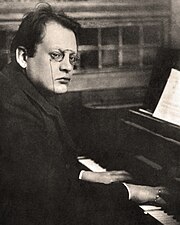Portal:Germany/Selected article/14

Der 100. Psalm (The 100th Psalm), Op. 106, is a composition in four movements by Max Reger in D major for mixed choir and orchestra, a late Romantic setting of Psalm 100. Reger began composing the work in 1908 for the 350th anniversary of Jena University. The occasion was celebrated that year with the premiere of Part I, conducted by Fritz Stein on 31 July. Reger completed the composition in 1909. It was published that year and premiered simultaneously on 23 February 1910 in Chemnitz, conducted by the composer, and in Breslau, conducted by Georg Dohrn.
Reger structured the text in four movements, as a choral symphony. He scored it for a four-part choir with often divided voices, a large symphony orchestra, and organ. He requested additional brass players for the climax in the last movement when four trumpets and four trombones play the melody of Luther's chorale "Ein feste Burg ist unser Gott". Reger used both late-Romantic features of harmony and dynamics, and polyphony in the Baroque tradition, culminating in the final movement, a double fugue with the added instrumental cantus firmus.
In 1922, the biographer Eugen Segnitz noted that this work, of intense expression, was unique in the sacred music of its period, with its convincing musical interpretation of the biblical text and manifold shades of emotion. Paul Hindemith wrote a trimmed adaption which probably helped to keep the work in the repertory, and François Callebout wrote an organ version, making the work accessible for smaller choirs. The organ version was first performed in 2003, in Wiesbaden where the composer studied. The celebration of the Reger Year 2016, reflecting the centenary of the composer's death, led to several performances of Der 100. Psalm. (Full article...)